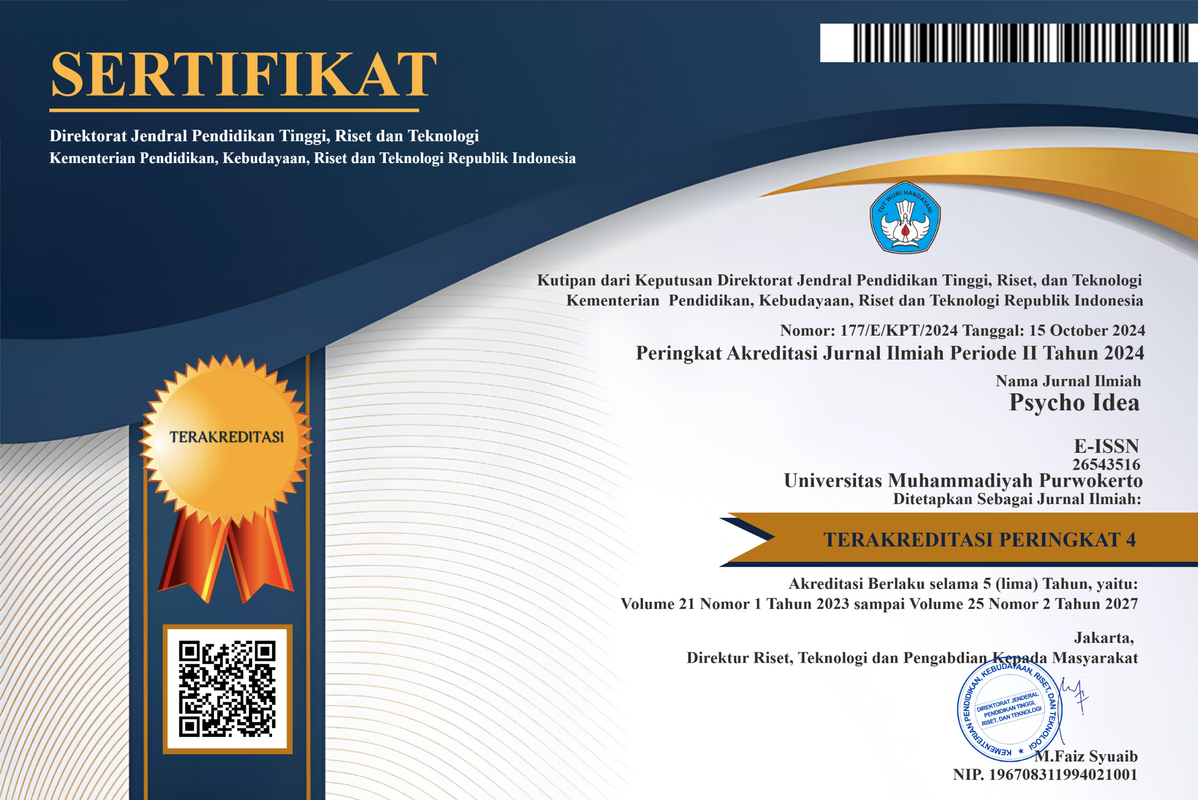MENGENALI GEJALA DAN PENYEBAB DARI CONDUCT DISORDER
DOI:
https://doi.org/10.30595/psychoidea.v8i1.194Abstract
Artikel ini bertujuan untuk mengkaji tentang Conduct disorder atau gangguan perilaku yang biasanya lebih sulit dideteksi dibanding jenis kebutuhan khusus lainnya. Sulitnya melakukan deteksi terhadap gangguan perilaku ini bukan hanya dikarenakan karakteristik dari populasi gangguan emosi dan perilaku ini yang beraneka ragam dan tipe penyimpangan yang berbeda-beda, namun juga karena kurangnya pemahaman masyakat tentang gejala dari gangguan perilaku ini. Sekalipun sulit untuk mengenali gangguan perilaku pada anak namun tetap harus ada upaya untuk melakukan deteksi lebih awal terhadap munculnya gangguan perilaku ini. Deteksi terhadap gangguan perilaku dimaksudkan sebagai suatu usaha seseorang, baik itu orang tua, guru atau masyarakat pada umumnya untuk mengetahui apakah seorang anak mengalami kelainan atau penyimpangan baik secara fisik, intelektual, sosial, emosional maupun tingkah laku dalam pertumbuhan atau perkembangannya dibandingkan dengan anak-anak lain seusianya. Salah satu cara untuk membantu kita dalam melakukan deteksi adalah dengan memahami terlebih dahulu pengertian, gejala dan penyebab dari conduct disorder itu sendiri. Kata Kunci : Conduct disorder/Gangguan perilakuReferences
Abrams, M. S. (1999). Intergenerational Transmission of Trauma: Recent Contributions from the Literature of Family Systems Approaches to Treatment. American Journal of Psychotherapy, 53, (2), 225–231.
Cimbora, D.M.,& McIntosh,D.N. 2003. Emotional Responses to Antisocial Acts in Adolescents Males With Conduct Disorder : A Link to Affective Morality. Journal of Clinical Child and Adolescent Psychology, 32, 2, 296-301.
Cohen P, Cohen J, Brook J (1993) An Epidemiological Study of Disorders in Late Childhood and Adolescence, II: Persistence of Disorders. Journal of Child Psychology and Psychiatry 34:869–877.
Conley, J. (1994). Conduct disorders. In B. Schonen Johnson (Ed.), Child and adolescent family and psychiatric nursing (pp.221–231). Philadelphia: Lippincott.
Constantino, J. N. (1992). On the prevention of conduct disorder: A rationale for initiating preventive efforts in infancy. Journal of Infants and Young Children, 5 (2), 29-41.
DeKlyen, M., Speltz, M. L., & Greenberg, M, T. (1998). Fathering and early onset conduct problems: Positive and negative parenting, father-son attachment, and the marital context. Clinical Child and Family Psychology Review 1, (1), 3–21.
Delligatti, Little&Little. (2003). Conduct Disorder in Girls Diagnostic and Intervention Issues. Psychology in the School, 40 (2)
Fidler, S. (1989). Violent deaths amongst first nations people in Saskatchewan. Unpublished master’s thesis, University of Saskatchewan, Saskatchewan Indian Federated College, Saskatoon, Saskatchewan.
Galvin, M., Eyck, R. T., Shekhar, A., Stilwell, B., Fineberg, N., Laite, G., & Karwisch, G. (1994). Serum dopamine beta hydroxylase and maltreatment in psychiatrically hospitalized boys. Child abuse and neglect. 19 (7), 821–832.
Hallahan, D.P. & Kauffman, J.M. (1988). Exceptional Children: Introduction to Special Education. 4th ed. New Jersey: Prentice Hall.
Holcomb, W. R., & Kashani, J. H. (1991). Personality characteristics of a community sample of adolescents with conduct disorder. Adolescence, 26, (103), 579–586.
Kazdin, A. E. (1997). A Model of Theory, Research & Practice. Journal of Clinical Child Psychology, 26, 129
Kazdin, A. E. & Crowley, M. J. (1997). Moderators of treatment outcome in cognitively based treatment of antisocial children. Cognitive therapy and research, 21, (2),185–207.
Kearney, C.A. (2003). Casebook In Child Behavior Disorder. Second edition. University of Nevada, Las Vegas
Matthys, W., Walterbos, W., Van Engeland, H., & Koops, W. (1995). Conduct-disorderedboys’ perceptions of their liked peers. Cognitive Therapy and Research, 19(3), 357–372.
McMillen, C. J., & Rideout, G. B. (1996). Breaking intergenerational cycles: Theoretical tools for social workers. Social Services Review, 70 (3) 379–399.
Oosterlaan, J., Logan, G. D., & Sergeant, J. A. (1998). Response Inhibition in AD/HD,CD, Comorbid AD/HD,CD, Anxious, and Control Children: A Meta-Analysis of Studies with the Stop Task. Journal of child psychology and psychiatry. 39 (3), 411–425.
Schonfeld, I. S., Shaffer, D., O’Connor, P., & Portnoy, S. (1988). Conduct Disorder and Cognitive Functioning: Testing three Causal Hypotheses. Child Development, 59, 993–1007.
Sunardi. (1996). Ortopedagogik Anak Tunalaras I, Depdiknas Dikti. http://www.ditplb.or.id/profile.
Videbeck, S. L. (2001). Psychiatric mental health nursing. Philadelphia, PA: Lippincott.
Werry, J. S. (1997). Severe Conduct Disorder. Some key issues. Canadian Journal of Psychiatry, 42, 577–583.
Wicks-Nelson, R., & Israel, A. D. (1997). Behavior Disorders of Childhood (3rd ed.). New Jersey: Prentice Hall.
Downloads
Published
Issue
Section
License
Authors published in this journal agree to the following terms:
- The copyright of each article is retained by the author (s) without restrictions
- The journal allows the author(s) to retain publishing rights without restrictions
- The author grants the journal the first publication rights with the work simultaneously licensed under the Creative Commons Attribution License, allowing others to share the work with an acknowledgment of authorship and the initial publication in this journal.
- Authors may enter into separate additional contractual agreements for the non-exclusive distribution of published journal versions of the work (for example, posting them to institutional repositories or publishing them in a book), with acknowledgment of their initial publication in this journal
- Authors are permitted and encouraged to post their work online (For example in the Institutional Repository or on their website) before and during the submission process, as this can lead to productive exchanges, as well as earlier and larger citations of published work
- Articles and all related material published are distributed under a Creative Commons Attribution-4.0 International Public License (CC - BY 4.0).
License
Psycho Idea is licensed under a Creative Commons Attribution- 4.0 International Public License (CC - BY 4.0).
You are free to :
Share — copy and redistribute the material in any medium or format
Adapt — remix, transform, and build upon the material for any purpose, even commercially











